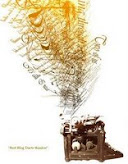George Bellows was born in Columbus, Ohio in 1882. He went to Ohio State University where he excelled at baseball. He was even encouraged to play professional ball. But his heart wasn’t in baseball; he was a painter. So in 1904, when he had nearly finished his degree, Bellows left the university and moved to New York City.
 He enrolled at the New York School of Art and became interested in painting the grittiest and dirtiest details of American life. There was a group of artists in the early 1900s who painted mainly city scenes that showed the lives of the poor. The artists, members of the Ash Can School, only showed their work together once and, at that time, Bellow’s paintings weren’t included. The term “Ash Can School” is used today for artists who painted in New York City during the early twentieth century and portrayed city life. Above is Cliff Dwelers, below is Men of the Docks and Steaming Streets.
He enrolled at the New York School of Art and became interested in painting the grittiest and dirtiest details of American life. There was a group of artists in the early 1900s who painted mainly city scenes that showed the lives of the poor. The artists, members of the Ash Can School, only showed their work together once and, at that time, Bellow’s paintings weren’t included. The term “Ash Can School” is used today for artists who painted in New York City during the early twentieth century and portrayed city life. Above is Cliff Dwelers, below is Men of the Docks and Steaming Streets.

 Bellows gained fame when he helped organized a show of city landscapes. His fame grew as he showed his work at judged art shows across the country. As he became a recognized artist, wealthy art lovers began to ask for portraits. Bellow continued to paint city scenes but he also painted many portraits, like the one shown below, Portrait of Emme in Night Light.
Bellows gained fame when he helped organized a show of city landscapes. His fame grew as he showed his work at judged art shows across the country. As he became a recognized artist, wealthy art lovers began to ask for portraits. Bellow continued to paint city scenes but he also painted many portraits, like the one shown below, Portrait of Emme in Night Light.
 When the U.S. became involved in World War I, Bellows deeply and publicly supported the decision. He enlisted at age 35 but was never sent abroad to fight. He used his art to show his passion and began painting war scenes. These paintings are very intense and so I will not show any here.
When the U.S. became involved in World War I, Bellows deeply and publicly supported the decision. He enlisted at age 35 but was never sent abroad to fight. He used his art to show his passion and began painting war scenes. These paintings are very intense and so I will not show any here.
What he was best known for, though, were his boxing paintings. These were painted later in his life and you can see that he had learned how to paint realistically. You can see even the sweat on the muscled bodies as they push against each other. One of his boxing pictures appeared on a U.S. Postal stamp. Below is the painting on the stamp, Shag at Starkeys.
 Besides painting, Bellows helped to spread the art of lithography. A lithograph is a copy of a painting made by applying the painting to a smooth, hard surface, and using certain chemicals to transfer the image to paper. Bellows had a lithography press in his studio and used it to create about 100 images.
Besides painting, Bellows helped to spread the art of lithography. A lithograph is a copy of a painting made by applying the painting to a smooth, hard surface, and using certain chemicals to transfer the image to paper. Bellows had a lithography press in his studio and used it to create about 100 images.
George Bellows died in 1925.
Return to main page.
 He enrolled at the New York School of Art and became interested in painting the grittiest and dirtiest details of American life. There was a group of artists in the early 1900s who painted mainly city scenes that showed the lives of the poor. The artists, members of the Ash Can School, only showed their work together once and, at that time, Bellow’s paintings weren’t included. The term “Ash Can School” is used today for artists who painted in New York City during the early twentieth century and portrayed city life. Above is Cliff Dwelers, below is Men of the Docks and Steaming Streets.
He enrolled at the New York School of Art and became interested in painting the grittiest and dirtiest details of American life. There was a group of artists in the early 1900s who painted mainly city scenes that showed the lives of the poor. The artists, members of the Ash Can School, only showed their work together once and, at that time, Bellow’s paintings weren’t included. The term “Ash Can School” is used today for artists who painted in New York City during the early twentieth century and portrayed city life. Above is Cliff Dwelers, below is Men of the Docks and Steaming Streets.
 Bellows gained fame when he helped organized a show of city landscapes. His fame grew as he showed his work at judged art shows across the country. As he became a recognized artist, wealthy art lovers began to ask for portraits. Bellow continued to paint city scenes but he also painted many portraits, like the one shown below, Portrait of Emme in Night Light.
Bellows gained fame when he helped organized a show of city landscapes. His fame grew as he showed his work at judged art shows across the country. As he became a recognized artist, wealthy art lovers began to ask for portraits. Bellow continued to paint city scenes but he also painted many portraits, like the one shown below, Portrait of Emme in Night Light. When the U.S. became involved in World War I, Bellows deeply and publicly supported the decision. He enlisted at age 35 but was never sent abroad to fight. He used his art to show his passion and began painting war scenes. These paintings are very intense and so I will not show any here.
When the U.S. became involved in World War I, Bellows deeply and publicly supported the decision. He enlisted at age 35 but was never sent abroad to fight. He used his art to show his passion and began painting war scenes. These paintings are very intense and so I will not show any here.What he was best known for, though, were his boxing paintings. These were painted later in his life and you can see that he had learned how to paint realistically. You can see even the sweat on the muscled bodies as they push against each other. One of his boxing pictures appeared on a U.S. Postal stamp. Below is the painting on the stamp, Shag at Starkeys.
 Besides painting, Bellows helped to spread the art of lithography. A lithograph is a copy of a painting made by applying the painting to a smooth, hard surface, and using certain chemicals to transfer the image to paper. Bellows had a lithography press in his studio and used it to create about 100 images.
Besides painting, Bellows helped to spread the art of lithography. A lithograph is a copy of a painting made by applying the painting to a smooth, hard surface, and using certain chemicals to transfer the image to paper. Bellows had a lithography press in his studio and used it to create about 100 images.George Bellows died in 1925.
Return to main page.








No comments:
Post a Comment